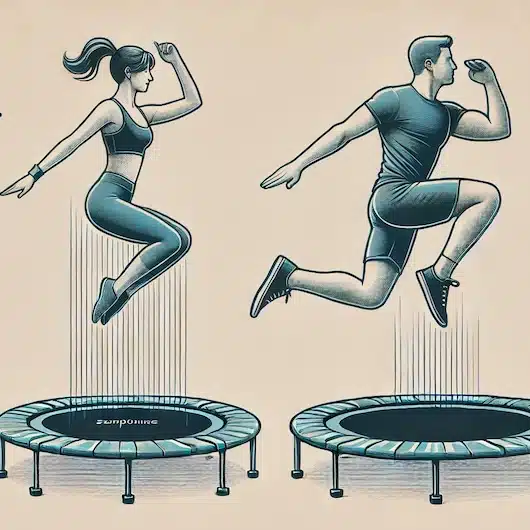
The Benefits of Rebounding (Trampoline Workout)
Rebounding or trampoline exercise is not just for kids, it is a powerful low impact workout with numerous health benefits. Whether it is fitness, lymphatic drainage or longevity that you are looking to improve, rebounding is a fun and effective way to enhance your wellness routine.It’s also an accessible method because you don’t need a large trampoline in your backyard to practice rebounding. Instead, you can just buy a small one that you place in any room you want. Keep reading to learn more about how rebounding and bouncing can strengthens the body.
What is Rebounding?
Rebounding involves jumping on a mini-trampoline, also called a rebounder. During rebounding you are rocking your body which activates your parasympathetic system. The pressure is also evenly distributed between different body parts, making it easy on joints and bones. In rebounding, cardio and strength training are combined in a way that gives you a full body workout. Rebounding has become popular among wellness enthusiasts, including people in biohacking circles, for its numerous advantages, which we will discuss in detail.
The Top Benefits of Rebounding Trampoline
Rebounding is not only a fun way to get moving but also a powerful workout with a wide range of health benefits. This low impact exercise is good for both your fitness and longevity goals, from boosting your cardiovascular health to improving lymphatic drainage. Let’s dive into the top reasons why you should include rebounding in your routine.
Improves Lymphatic Drainage
One of the most unique benefits of rebounding is that it helps in enhancing lymphatic circulation. The up and down motion stimulates the lymphatic system to help your body detoxify by flushing out toxins and enhancing immune function.
Enhances Cardiovascular Health
Rebounding is a great cardiovascular workout that gets your heart rate up and improves your circulation. It is a great alternative to running or jogging, with similar cardio benefits and much less impact on your joints.
Low-Impact on Joints
Compared to high impact exercises like running, rebounding absorbs the shock of movement, making it ideal for those with joint pain or injuries. This makes it a sustainable option for long term fitness because of its low impact nature.
Boosts Balance and Coordination
Rebounding requires maintaining stability on a moving surface, which helps improve balance, coordination, and proprioception (your sense of body position).
Supports Bone Health
Jumping on a trampoline applies gentle stress to your bones, which can stimulate bone density and prevent age-related bone loss, such as osteoporosis. This makes rebounding especially
beneficial for older adults.
Elevates Your Mood
Just a few minutes of bouncing can trigger the release of endorphins. These are your body’s feel-good hormones. Rebounding is not only great for your physical health but also a fantastic way to relieve stress and boost your mental well-being.
How to Get Started with Rebounding
Starting a rebounding routine is simple:
Find the Right Equipment: Invest in a high-quality rebounder with sturdy springs and a stable base.
Ease Into It: Start with short sessions of 5–10 minutes to get accustomed to the movement.
Mix It Up: Add variations like jogging in place, jumping jacks, or high knees for a more intense workout.
Be Consistent: Aim for 15–20 minutes, 3–5 times per week, for optimal results.

Scientific Support for Rebounding
One of the most compelling studies on rebounding is study by NASA in 1980 was recorded by the Journal of Applied Physiology. This study found that trampoline exercise is not only effective but also more efficient than running. The NASA Technical Report states that rebounding is 68% more effective at cardiovascular fitness than jogging and puts less strain on the joints. This makes rebounding an ideal workout for individuals of all fitness levels, offering a high-impact result with low-impact effort.
Final Thoughts on Trampoline Workout
Rebounding is not just a workout it is a scientifically backed way to support your overall health. In fact, NASA’s research says it’s even more efficient than jogging, making it a great way to improve your cardiovascular health with less impact on your body. Whether you jump for better lymphatic flow, stronger bones, or just a boost in mood, rebounding is a fun and impactful way to put your well being first. If you’re into longevity and biohacking, this is definitely a technique you should add to your weekly health protocol.



